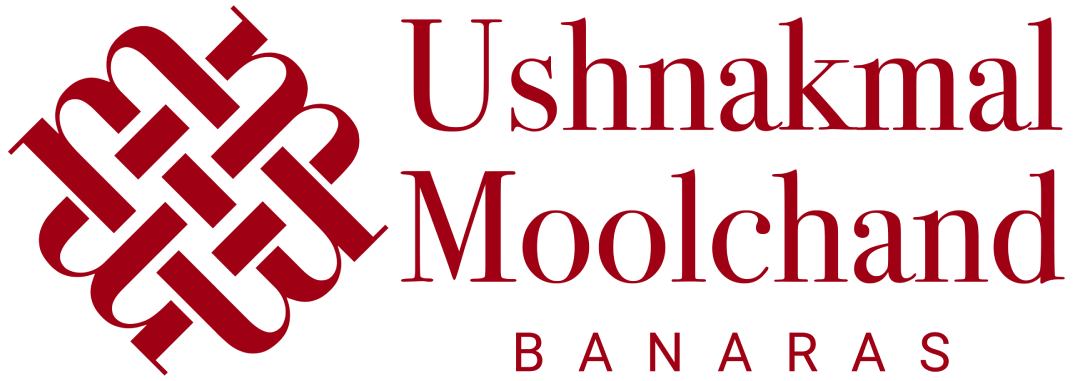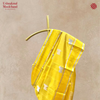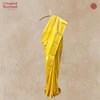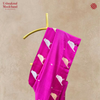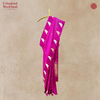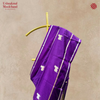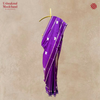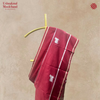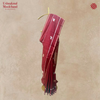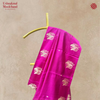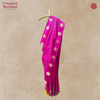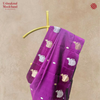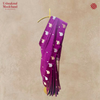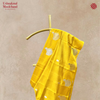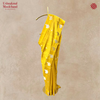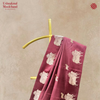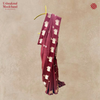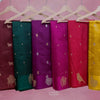
The Banarasi Glossary: Decode the magic in every motif
Banaras doesn’t just weave fabric, it weaves meaning. Every line, leaf, and lattice carries a memory of the loom and the hands that guide it. As an eighth-generation, family-run house, we’ve grown up learning these words at the gaddi, not from books. Here’s a living glossary from our workbenches to yours, so when you choose a Banarasi saree, you also understand its language.
Fibres & Fabrics
Katan Silk: Pure mulberry silk with silk warp and silk weft. Smooth, durable, and ideal for intricate brocade and Kadhuwa weave.
Kora (Organza): Crisp, translucent silk with a light body and gentle stiffness; perfect for airy brocades and bridal pastels.
Tissue: Silk (or silk blend) interwoven with metallic zari for a luminous, sheer surface that catches the light.
Georgette / Chiffon (Silk): Lightweight, fluid silk fabrics used for contemporary Banarasi drapes, often with meenakari or small butis.
Tussar / Munga: Wild silks with a soft sheen and natural texture; pair beautifully with antique zari and earthy palettes.
Shattir: A versatile silk ground used historically in Banarasi weaving for patterns that require stability with lightness.
Loom & Weave Techniques
Kadhua (Kadhwa): Motifs are woven individually on the loom (not run continuously). Labour-intensive, long-lasting, and crisp in detail. If a motif looks “placed” and clean on both sides, it’s likely kadhua.
Phekwa (Fekwa): Supplementary weft runs across the width; floats are carried and later snipped at the back. Efficient for all-over jaals and repeating butis.
Katraua (Cutwork): After weaving, extra weft floats are carefully cut out to reveal a more open, lace-like motif field.
Meenakari: Coloured silk threads (and sometimes coloured metallics) inserted as extra wefts to “enamel” motifs from within, think tiny berries, petals, or veins glowing in contrast.
Brocade / Kimkhwab: Rich supplementary-weft weaving with zari on silk. Kimkhwab is the most opulent form, dense zari, regal motifs, heirloom weight.
Jamdani (Banarasi Jamdani): Extra-weft insertion done by hand on a sheer or fine ground, producing motifs that look as if they float in the fabric.
Tanchoi: Figure weaving using multiple coloured wefts for intricate, repeating patterns (often florals) without zari.
Kadiyal (Contrast): A technique to achieve a contrasting border and pallu on a differently coloured body by interlocking/weaving sections with separate shuttles.
Rangkat: Multi-hued “ranged” colouration across the warp or weft to create elegant, colour-blocked bands within one saree; a master’s playground.
Gyasar: Heavy, temple-inspired brocade with bold, often Tibetan or Buddhist iconography; woven on special looms in Banaras for monastery and ceremonial textiles.
Design Layouts
Buti / Boota: Single small (buti) or medium (boota) motifs scattered or aligned across the body. Common types include ashrafi (coin), badami (almond), phool (floral), paan (leaf).
Bel: A meandering vine that runs lengthwise or across the saree, delicate trails binding flowers and leaves.
Jaal: An all-over lattice or network (trellis) of vines, leaves, and florals that covers the body richly.
Jangla: Large, luxuriant creepers climbing across the drape; dramatic, old-world bridal grandeur.
Shikargah: Narrative “hunting scene” layouts with deer, elephants, birds, and foliage, a storytelling classic of courtly textiles.
Bootidar: A field sprinkled with repeating small butis; balanced, timeless, and versatile.
Koniyas: Corner motifs at the pallu end that frame the fall, often paisleys or lotus clusters.
Motifs & Their Meanings
Kalka / Paisley / Kairi: A stylised mango; abundance, fertility, auspicious beginnings.
Kamal (Lotus): Purity and rebirth; from tight buds to full blooms, the lotus is a Banarasi signature.
Ashrafi Buti: Coin-shaped motif; prosperity and good fortune.
Bel-Patta / Paan: Leaf forms symbolising freshness, celebration, and sacred offerings.
Genda / Gulab / Champa: Marigold, rose, champa florals; festive devotion, romance, and grace.
Mor (Peacock): Joy, monsoon, and beauty; often paired with vines in meenakari.
Hathphool / Jharokha / Jhumka: Jewellery-inspired forms referencing Mughal-Rajput aesthetics of adornment and architecture.
Zari & Colour
Sona-Rupa: Gold (sona) and silver (rupa) zari woven together for rich dual-metal highlights.
Antique Zari: Muted, vintage-toned metal threads (smoky gold/old silver) for a softer, heirloom look.
Real vs. Tested Zari: Real (pure) zari uses precious metal drawn over silk/cotton core; tested zari uses metallised film. Both are used in Banarasi weaving; weight, patina, and price vary accordingly.
Ganga-Jamuna: Contrasting borders (or selvedges) on either side; two rivers, two colours, one flow.
Rang (Palette): From kashish (smoky grey) and gulabi (pink) to neelam (sapphire) and kachnar (orchid), Banarasi colour names are as poetic as the textiles.
Anatomy of a Saree
Body (Jangha): The main field; may be plain, butidar, or jaal-covered.
Border (Kinar): Runs along the length; narrow patti to grand temple borders, often in kadhua or brocade.
Pallu (Anchal): Decorative end of the saree; heavier zari, koniyas, bold bels or jaals.
Selvedge (Gundi / Bacha): Woven self-edge that prevents fraying; sometimes colour-tipped for character.
Fall & Pico: Finishing stitches along the inner edge and hem for a clean drape and protection.
Classic Banarasi Types You’ll Hear About
Kadhua Brocade: Katan or kora ground with individually woven zari motifs; crisp, enduring details.
Jamdani on Kora / Tissue: Sheer elegance; motifs appear suspended, perfect for ethereal occasion wear.
Kimkhwab Bridal: Dense zari figure weaving; ceremonial, weighty, and forever.
Butidar Katan: All-over small butis on pure silk; versatile heirloom.
Shikargah Katan/Kora: Narrative grandeur for trousseau and collectors.
Rangkat Katan: Colour-blocked finesse with sophisticated transitions across the drape.
Tanchoi Silks: Zari-less figure weaving in multicolour wefts; refined, modern-classic.
How to Read (and Love) Your Banarasi
-
Look at the back.
Clean backs with no long floats usually indicate kadhua; neat, short snips suggest phekwa or cutwork. Neither is “better” ; each serves a different design purpose. -
Feel the hand.
Katan feels smooth and strong; kora is crisp; tissue glows and is lightly stiff; georgette/chiffon are fluid. -
Watch the light.
Meenakari pops in colour; antique zari glows softly; tissue and kimkhwab shimmer richly. -
Think longevity.
Store in breathable bags, refold periodically, keep away from direct sunlight and perfumes. Dry clean by specialists used to handloom silks.
Why this language matters
When you know the difference between a bel and a jaal, or recognise a kadhua kalka at a glance, you don’t just buy a saree, you adopt a story. And that’s what we have safeguarded since 1885.
At Ushnakmal Moolchand Banaras, we curate, design, and weave with this very vocabulary; patiently, honestly, and with pride. If you ever want to decode a weave you own (or plan to), bring it to our gaddi in Kunj Gali, Chowk or write to us. We’ll read its story together.
Ushnakmal Moolchand Banaras — From Generations, For Generations.
